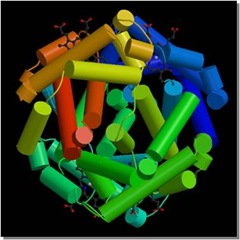1. An average protein will not be denatured by:

A) a detergent such as sodium dodecyl sulfate (SDS).
B) heating to 90°C.
C) iodoacetic acid.
D) pH 10.
E) urea.
2. Which of the following is least likely to result in protein denaturation?
A) Altering net charge by changing pH
B) Changing the salt concentration
C) Disruption of weak interactions by boiling
D) Exposure to detergents
E) Mixing with organic solvents such as acetone
A) providing a protective environment in which proteins can fold properly
B) degrading proteins that have folded improperly
C) providing a template for how the proteins should fold
D) rescuing proteins that folded incorrectly and allowing them to refold into proper configuration.
E) all of the above
4. Which of the following statements concerning the process of spontaneous folding of proteins is false?
A) It may be an essentially random process.
B) It may be defective in some human diseases.
C) It may involve a gradually decreasing range of conformational species.
D) It may involve initial formation of a highly compact state.
E) It may involve initial formation of local secondary structure.
5. Protein S will fold into its native conformation only when protein Q is also present in the solution. However, protein Q can fold into its native conformation without protein S. Protein Q, therefore, may function as a ---------- for protein S.
A) ligand
B) molecular chaperone
C) protein precursor
D) structural motif
E) supersecondary structural unit
6. Which of the following is not known to be involved in the process of assisted folding of proteins?
A) Chaperonins
B) Disulfide interchange
C) Heat shock proteins
D) Peptide bond hydrolysis
E) Peptide bond isomerization
7. Experiments on denaturation and renaturation after the reduction and reoxidation of the —S—S— bonds in the enzyme ribonuclease (RNase) have shown that:
A) folding of denatured RNase into the native, active conformation, requires the input of energy in the form of heat.
B) native ribonuclease does not have a unique secondary and tertiary structure.
C) the completely unfolded enzyme, with all —S—S— bonds broken, is still enzymatically active.
D) the enzyme, dissolved in water, is thermodynamically stable relative to the mixture of amino acids whose residues are contained in RNase.
E) the primary sequence of RNase is sufficient to determine its specific secondary and tertiary structure.
Learn more:
1. C) iodoacetic acid.
2. B) Changing the salt concentration
3. D) rescuing proteins that folded incorrectly and allowing them to refold into proper configuration.
4. A) It may be an essentially random process.
5. B) molecular chaperone
6. D) Peptide bond hydrolysis
7. E) the primary sequence of RNase is sufficient to determine its specific secondary and tertiary structure.

A) a detergent such as sodium dodecyl sulfate (SDS).
B) heating to 90°C.
C) iodoacetic acid.
D) pH 10.
E) urea.
2. Which of the following is least likely to result in protein denaturation?
A) Altering net charge by changing pH
B) Changing the salt concentration
C) Disruption of weak interactions by boiling
D) Exposure to detergents
E) Mixing with organic solvents such as acetone
3. Chaperone proteins function by
A) providing a protective environment in which proteins can fold properly
B) degrading proteins that have folded improperly
C) providing a template for how the proteins should fold
D) rescuing proteins that folded incorrectly and allowing them to refold into proper configuration.
E) all of the above
4. Which of the following statements concerning the process of spontaneous folding of proteins is false?
A) It may be an essentially random process.
B) It may be defective in some human diseases.
C) It may involve a gradually decreasing range of conformational species.
D) It may involve initial formation of a highly compact state.
E) It may involve initial formation of local secondary structure.
5. Protein S will fold into its native conformation only when protein Q is also present in the solution. However, protein Q can fold into its native conformation without protein S. Protein Q, therefore, may function as a ---------- for protein S.
A) ligand
B) molecular chaperone
C) protein precursor
D) structural motif
E) supersecondary structural unit
6. Which of the following is not known to be involved in the process of assisted folding of proteins?
A) Chaperonins
B) Disulfide interchange
C) Heat shock proteins
D) Peptide bond hydrolysis
E) Peptide bond isomerization
7. Experiments on denaturation and renaturation after the reduction and reoxidation of the —S—S— bonds in the enzyme ribonuclease (RNase) have shown that:
A) folding of denatured RNase into the native, active conformation, requires the input of energy in the form of heat.
B) native ribonuclease does not have a unique secondary and tertiary structure.
C) the completely unfolded enzyme, with all —S—S— bonds broken, is still enzymatically active.
D) the enzyme, dissolved in water, is thermodynamically stable relative to the mixture of amino acids whose residues are contained in RNase.
E) the primary sequence of RNase is sufficient to determine its specific secondary and tertiary structure.
Learn more:
- Biochemistry Questions on Proteins
- Biochemistry Review Questions and Answers
- Video on Protein Folding
1. C) iodoacetic acid.
2. B) Changing the salt concentration
3. D) rescuing proteins that folded incorrectly and allowing them to refold into proper configuration.
4. A) It may be an essentially random process.
5. B) molecular chaperone
6. D) Peptide bond hydrolysis
7. E) the primary sequence of RNase is sufficient to determine its specific secondary and tertiary structure.
Tags:
biochemistry exam questions
Biochemistry multiple choice
MCQ on Protein Denaturation
MCQ on Protein Folding
Protein Denaturation
Protein Folding

thank u for giving more informative and thought provoking blog i like it very much.... expect more subject oriented few more details and also online books and articles retriving system..
ReplyDelete